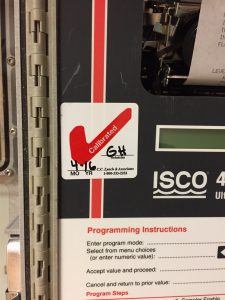Top FAQs on Third Party Flow Meter Calibration
What is third party flow meter calibration?
Third party flow meter calibration is when a recognized independent service company tests and adjusts your flow meter(s) for optimum performance, following the manufacturer’s recommended procedure.
Why do I need third party flow meter calibration?
There are several reasons third party calibration is recommended, including:
- Most permits require third party calibration; at least annually. Current calibration records always help with inspections. Out-dated calibrations are often cited.
- For optimum plant performance, flow is such a critical component to plant operation. Third party calibration ensures your meters are giving you the best information for control and adjustment.
- Third party calibrations include preventative maintenance procedures to limit costly repairs resulting from equipment neglect.
- For plants out of balance (Influent ≠ Effluent), routine calibration can minimize the difference.
- For billing locations, lack of proper calibration can equate to loss in revenue or disputed totals.
- Over time, flow meters will drift from their original factory calibration. As mechanical components, liners and electronics fade, a re-validation by a third party can identify operating issues.
How often should I get my meters calibrated by a third party?
At least annually. For billing locations, more frequent attention is advised. Also, any time trouble is suspected.
What is involved with a third party calibration?
- Any prescribed preventive maintenance; general inspection.
- Confirm proper programming, run any diagnostic checks.
- Sensor inspection for proper mounting, maintenance and signal strength.
- Check signal outputs for proper scaling.
- Verify level accuracy, making necessary adjustments.
- Confirm level to flow calculation and totalizer is accurate.
- On open channel applications, primary devices (flume or weir) should be inspected for dimensional fidelity, proper installation, maintenance and operation.
- For Closed Pipe applications, often a clamp-on validity flow meter is attached for comparative readings.
What should I look for in a service company?
- Trained, experienced technicians
- Drug screening / background check / current safety plan
- Rental/loaner equipment available
- In-house repair service and parts stocking
- Strong documentation, field worksheets, certificates, recordkeeping
How can I prepare for testing?
Calibrations are more comprehensive if flow is modulated during testing. Plan in advance to provide low/med/high flow rate; and you can be sure your flow meter works accurately across changing flow conditions.
What can I do to make sure I know when to recalibrate?
Make certain your technician leaves a weather-resistant decal indicating date of calibration and service company information. Place it right on the meter face to help you keep it current and ensure it’s the first an inspector sees on a visit.
You can also circle back and check the meter yourself, now and then, until you are comfortable with the calibration frequency interval.
